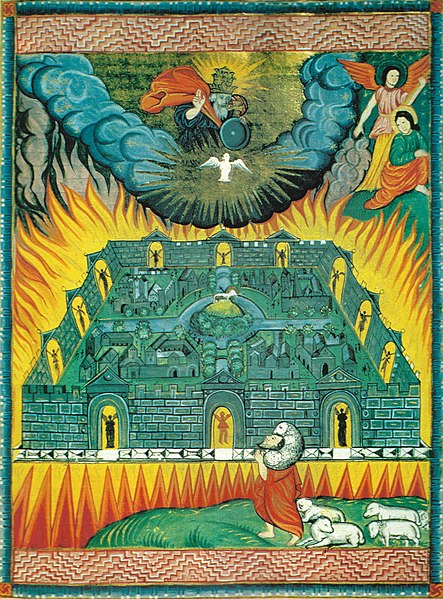Imagining Eternity

For more on Armenian art and culture and to learn how it is that Armenians came to live in Iran, see:
Dickran Kouymjian Armenian Art: An Overview
Julfa in Encyclopedia Iranica Online
This little painting was made in 1645 by Malnazar and Aghap’ir, a pair of Armenian illuminators living in the Armenian community of New Julfa, a suburb of the Persian (Iranian) city of Isfahan, then the capital of the Persian empire. Illuminators create illuminations, the small illustrations and visual embellishments that are a feature of handmade medieval books, in this case, a Bible. This little painting, for all its detail, measures under 8 x 10 inches.
The image is that of the New Jerusalem coming down from heaven, as described in the vision given to John the Apostle and recorded in the Book of Revelation. We can see several of the features described by John. The whole city glows with a radiance of a jewel and, because it is descending from heaven, it doesn’t quite touch the ground.
There are twelve gates facing each of the four directions and each guarded by an angel. The lamb who is Jesus sits enthroned in the center of the city. The river of life, which is described as flowing from the throne, flows in all four directions from that center but stops at the city gates. The tree of life is impossibly described by John as growing on both sides of the river and this little painting solves that problem by presenting the tree of life as several trees, each with a spherical top, growing along all four branches of the river. God the Father presides over the whole display with a raised right hand, an indication that God is speaking. The Holy Spirit is also present in the form of a dove. The angel that has been directing John’s attention is present in the upper right hand corner, holding the golden measuring rod with which to measure the city and so demonstrate its perfection. John sees it all from his place at the bottom of the image. Ever the pastor, he’s accompanied by sheep.
Some describe Armenian art from this period as naive or primitive. To give some context, the great painters of the Italian renaissance, like Michelangelo and DaVinci, noted for their attention to anatomy and light, were working a century before Malnazar and Aghap’ir produced this image. Next to the ceiling of the Sistine Chapel, or the Mona Lisa, this painting of the New Jerusalem looks almost like a cartoon. I think that this is its genius.
We can tell right away that this is not a realistic depiction of any known geography. There is nothing photographic about this fanciful image. As such, it conforms to John’s text which uses everyday words to describe things that defy description: How does a city descend to earth? How does a lamb provide light like a lamp? What kind of tree grows on both sides of a river? The description of the New Jerusalem is a reminder that for us who are bounded by time and space, eternity defies human knowledge and description because we have no first-hand experience.
Today is All Saints Day, a day set aside for giving thanks for the eternal inheritance given to those who had died in the past year. As part of our commemoration Ofrendas (offerings) – elaborately decorated altars in memory of those who have died – will be in several locations on campus, including the Union (Grand Lounge), the Library (2nd Floor Lobby), Loke Hall, and the Gloria Christi Chapel. Traditional ofrenda decorations such as sugar skulls (calaveras), perforated paper (papel picado), and bread of the dead (pan de muerto) along with photographs of the beloved dead. During this coming Sunday morning’s prayers, all the names of those who have died in the past year and are known to us will be read aloud. These traditions of decoration and memory speak to the depth of our loss and the fragility of life. We remember the blessed dead but we have no access to their experience of eternity. Like the little Armenian painting, our decorations and rituals are not at all “realistic” in any empirical sense because the reality of eternity exceeds our empirical grasp. They are, however, poetically true, and they help us lean into the promise of peace with God and a resurrection pioneered by Jesus Christ.
Like this little Armenian painting, what we know will necessarily fall away when we see God face to face.
Peace be with you,
– Pr. Jim
Nov. 1, 2023
Rev. Katherine Museus and Rev. James A. Wetzstein serve as university pastors at the Chapel of the Resurrection at Valparaiso University and take turns writing weekly devotions.
- James Wetzstein
- The Wonder of Resurrection
- Forgiveness: The Necessary Miracle
- Everything Happens for a Reason or Does It?
- Of Groundhogs and Divine Love
- When You Pass Through the Fire…
- KHESED
- Psalm 46 – When There’s Trouble, God Can Always Be Located
- Who Are Your Beatitudes Mentors?
- The Posture of Gratefulness
- Like a Mirror of Eternal Truth
- “Light” and Other “L” Words
- Keeping Up with the Holy Spirit
- It’s a Three Day Weekend!
- Divine Love Can’t Quit You
- I Had a Bit of a Moment
- What to do When Our Resolutions Don’t Deliver
- Have Yourself a Merry Little Christmas (Somehow)
- Adventing in the Meantime
- Life and Death Collisions
- Imagining Eternity
- Where is God for You?
- All You Need Is Love, Love Is All You Need
- God Uses Crooked Sticks to Draw Straight Lines
- “Reset/Refresh” Sabbath as rest, not distraction